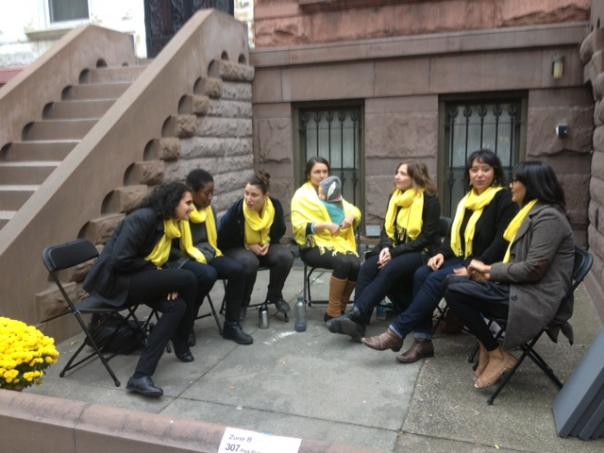Suzanne Lacy's Stoop Talk: Gender, Labor, and Gentrification
Posted on
On October 19th, a group of seven mixed-race and multigenerational oral history interviewers, narrators, and staff (and one baby!) from Crossing Borders, Bridging Generations participated in inspiring, critical and fun conversations about gender, labor, feminism, and gentrification as part of Between the Door and the Street, a public arts performance featuring over 300 women in Prospect Heights, Brooklyn.
Between the Door and Street, initiated by artist Suzanne Lacy and organized by Creative Time and Brooklyn Museum, showcased unscripted, public conversations about various oppressions impacting women globally. As hundreds of women sat on stoops and talked candidly about issues such as domestic violence, homophobia and transphobia, devaluing of women's labor, barriers to affordable childcare, immigration and more, audience members circulated in the street, eavesdropped, and constructed their own narratives through listening. Given Crossing Borders, Bridging Generations' programmatic emphasis on storytelling, oral history collection and deep listening as foundational tools for transformative change, it made perfect sense for us to talk, share and participate!
Read a review of the public art performance here: "On Brooklyn Stoops, Artist Cultivate Debates" (The New York Times, 10/20/2013).
Our group consisted of oral history interviewers Jeanmarie Theobalds, April Reynosa, Manissa McCleave Maharawal, narrators Leina Bocar and Emily Pinkowitz, Project Associate Nayantara Sen, and baby Arley (April's son).
In our circle, we explored conditions of labor within a capitalist society as they relate to women and mothers. We talked about how mothering is both naturalized as well as devalued, and relegated to under-appreciated, unpaid labor. We talked about how experiences of career-orientation and professionalism impact women - often men might feel they can 'rebel' against the system by divesting from, or rejecting professional expectations on them, while women conversely 'rebel' by working extremely hard and insisting on professional success, because they are fighting to disprove a patriarchal system that assumes their professional inferiority or failure.
Members of our group also talked about the devaluing of women's labor that enables social and cultural reproduction (for example, labor such as cooking food; transmitting language, culture, and traditions to children; child-rearing; functioning as social glue within family units), and women's affective, emotional and empathetic labor (supporting friends and family, holding emotional space for trauma and pain, being leaned on for support as 'natural' sources of empathy). Our group agreed that all of these functions constitute real, difficult and time-consuming work, and that we must find more ways to bring allied men (brothers, fathers, partners, husbands and friends) into feminist labor-sharing arrangements.
We also talked about our experiences living in Brooklyn and Harlem neighborhoods, and how discourses of public safety for women and children often play into forces for gentrification. Our stoop participants shared stories about how gentrifying influences are artificially naturalized, leading individuals to feel helpless in counteracting large-scale, structural gentrifying policies and practices that benefit wealthy property owners but displace our families. We explored some ways in which women's safety get entangled with racist, classist depictions of New York neighborhoods, and ways in which ideas about women and children's protection and safety are invoked to legitimize displacement, gentrification, violence against people of color, and war.
As a circle of feminist women coming to our Stoop with varied heritages, backgrounds and experiences, it was an incredible experience to share time and conversation with each other. Crossing Borders, Bridging Generations hopes to continue to open up space for dialogue and learning for our community of engaged interviewers and narrators, as well as for the general public through our seasonal public programs and our oral history archives.


